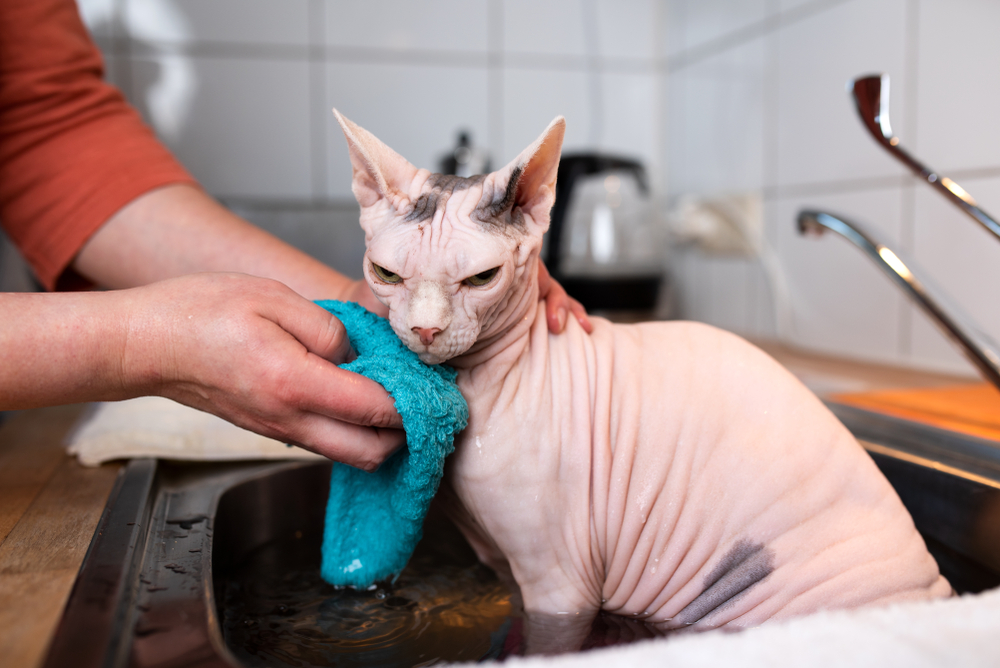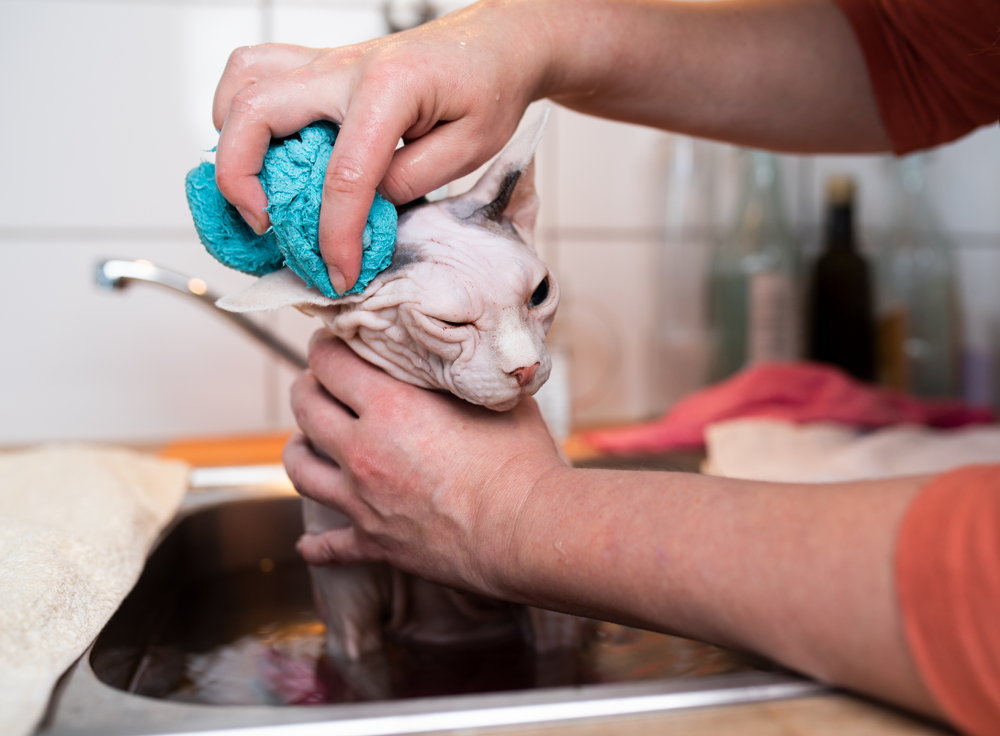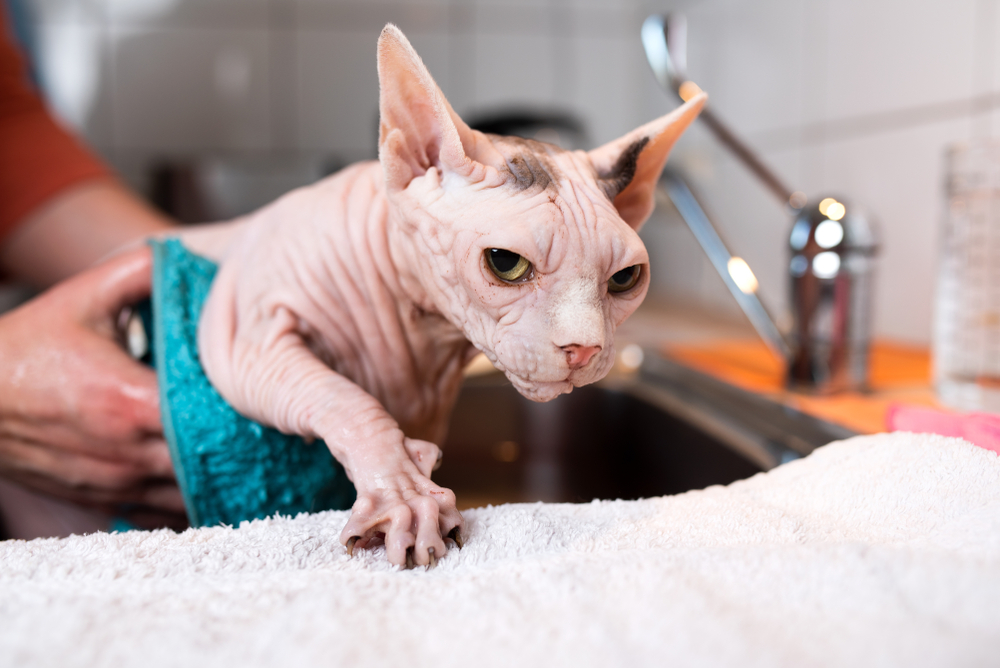
With their dainty limbs and friendly demeanor, hairless cats have amassed a devoted following in the past few decades. Aficionados often describe their personalities as doglike, with many insisting you’ll never go back to so-called “normal” breeds once you’ve owned a hairless cat. You might think the absence of a thick coat means they’re easy to groom, but hairless cat care actually takes more work than most people expect. Here’s what you need to know about hairless cat bath time, from how often you should bathe your cat to the best way to keep your mostly naked buddy warm and comfortable.
Maintaining your hairless cat’s skin health
Just as we know that healthy hair begins with a healthy scalp, the same applies to cats. And despite the name, hairless cats aren’t really hairless. While they lack the dense coat found on furred cats, hairless cats are covered in a fine layer of whisper-soft hair. To keep your hairless cat’s skin — and her downy, invisible fur — as healthy as possible, regular baths are essential. A cat’s skin produces oil the same way ours does. Unlike furred cats, hairless cats don’t have a thick coat to wick it away, which leads to an oily buildup on their skin. If your cat isn’t bathed frequently, they may leave an oily residue behind on your furniture and bedding.
Giving your hairless cat a bath
When bathing a hairless cat, the goal is to remove the excess oil that accumulates on your cat’s skin without leaving her skin stripped of all moisture. Opt for weekly baths with lukewarm (or warm) water and a hypoallergenic cat shampoo. Hairless cats typically have extremely sensitive skin, so look for a fragrance-free, dye-free shampoo that’s unlikely to cause a skin reaction.
Make sure you rinse your cat thoroughly, as residue may cause itching and irritation. Use a soft towel to dry off your hairless cat as soon as bath time is over — microfiber towels are a fantastic option for a sphynx’s delicate skin — so she won’t get cold.
Many pet parents dress their hairless cats in sweaters to keep them warm. Not all cats tolerate wearing clothes, but if your cat enjoys it, choose soft fabrics like cotton and fleece. If it feels scratchy to you, it’s definitely going to be uncomfortable for your hairless cat.

Don’t skip regular ear cleanings
Just as fur helps wick away moisture, it also prevents the ears from becoming dirty. Waxy buildup, dirt, and debris can clog the ear canal, leading to painful infections that, left untreated, may cause your cat to lose her hearing. You’ll need to clean your hairless cat’s ears weekly with a cleanser specifically designed for the ears. The instructions may say to apply the cleanser directly to the ear, but since most cats hate getting wet, it’s generally more effective (and less stressful for your feline friend) to soak a cotton ball and gently wipe out her ears.
Keep an eye out for feline acne
Just like many teenagers — and adults — hairless cats are prone to feline acne due to their oily skin. Feline acne most often presents as a rashlike area peppered with tiny black dots, called blackheads, on the chin and lower lip area, though breakouts can also occur around the base of your hairless cat’s tail. You may also see whiteheads, characterized by raised bumps with white tops.
Keeping your hairless cat clean will help reduce the risk of feline acne, but as we know, acne actually isn’t caused by dirt. The real cause of acne is clogged hair follicles and sebaceous glands. You’ll want to use a gentle, anti-bacterial soap to treat breakouts. Avoid topical medications with peroxide or alcohol, which are too harsh for your cat’s sensitive skin. If your cat still experiences breakouts, you may want to speak to your vet.
Frequent nail trims are a must
Because hairless cats don’t have fur on their feet, dirt and debris can build up beneath their nails. The ASPCA recommends regular trims every 10–14 days. Play with your cat’s paws often so she’s less likely to think anything is amiss when it comes time for her trim. Never cut past the transparent edge of the nail, as cutting into the quick will cause bleeding and discomfort. Trying to trim all her nails at once may be stressful, so we recommend going slowly and taking it a few claws at a time. If your cat refuses to hold still long enough for a trim, take her to the vet or your favorite groomer.

Hairless cats are known for their sweet personalities and often-clingy mannerisms. While it’s possible your hairless cat loves cuddling so much because you’re a constant source of heat, it’s impossible not to welcome her frequent snuggles. Not only do hairless cats form close bonds with their pet parents, but they’re also fond of children, other cats, and dogs. Hairless cats require a lot more work than you might expect, but if you’re willing to spend the time and effort, you’ll have a loyal, affectionate friend for years to come.



